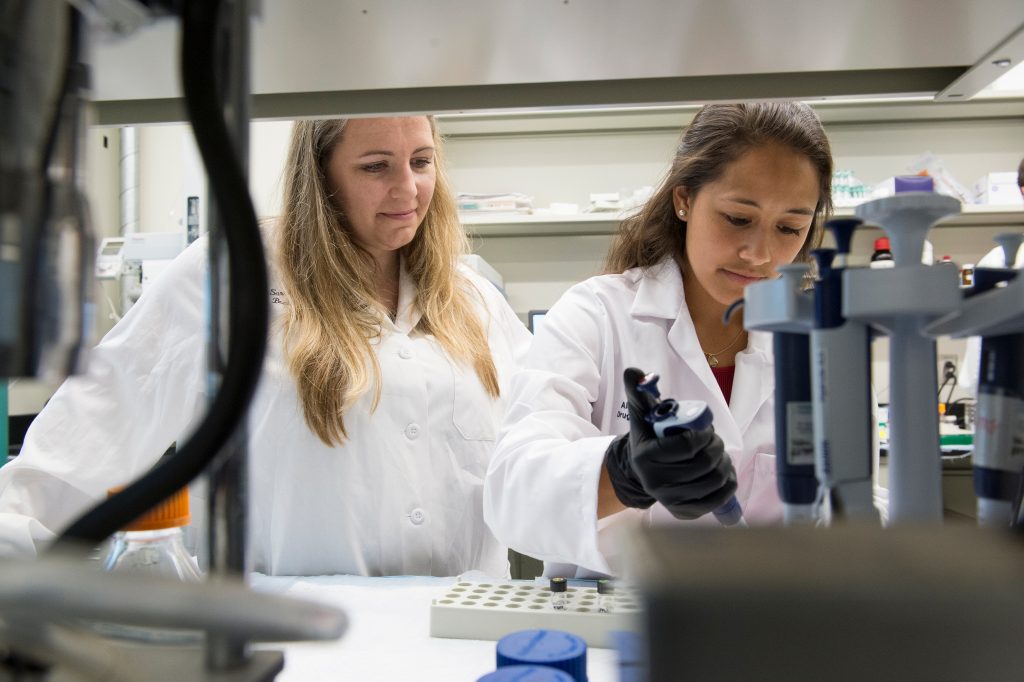6-Diazo-5-oxo-L-norleucine (DON), an unconventional amino acid having a structure similar to that of L-glutamine, was first isolated in the 1950’s from Streptomyces bacteria.1,2 DON broadly blocks glutamine utilizing reactions in cancer cells, and has shown robust efficacy in both preclinical cancer models and exploratory clinical studies.3,4,5 However, the clinical development of DON was halted, in part due to gastrointestinal toxicities,3 as the GI system is highly glutamine utilizing. Given DON’s promising efficacy in treating “glutamine-addicted” tumors, JHDD worked with chemists at the Institute of Organic Chemistry and Biochemistry (IOCB) in Prague to create DON prodrugs which deliver DON selectively to the tumor while minimizing its peripheral toxicity. Our novel tumor-targeted prodrugs of DON circulate intact and inert in plasma and are preferentially biotransformed to DON in tumor cells, permitting significant dose reduction and improved therapeutic index. Taking advantage of the elevated activities of specific tumor associated proteases, we have identified prodrugs that are stable in the gut but preferentially release DON in tumors. Furthermore, as a potential treatment for brain cancers and other neurological and psychiatric disorders, we have employed a distinct prodrug strategy to deliver DON preferentially to the brain while minimizing its peripheral exposure and thus GI toxicity. These prodrugs, by introduction of steric bulk and hydrophobic groups, are aimed to circulate intact and inert in plasma, but permeate and cleaved to release DON once inside the brain.6,7
REFERENCES
-
DeWald HA, Moore AM. “6-Diazo-5-oxo-L-norleucine, a New Tumor-inhibitory Substance. 1a Preparation of L-, D-and DL-Forms1b.” Journal of the American Chemical Society, 1958, 80 (15), 3941-3945
-
Nawrat CC, Moody CJ. “Natural products containing a diazo group.” Natural product reports, 2011, 28 (8), 1426-1444 [PubMed]
-
Magill GB, Myers WP, Reilly HC, Putnam RC, Magill JW, Sykes MP, Escher GC, Karnofsky DA, Burchenal JH. “Pharmacological and initial therapeutic observations on 6-diazo-5-oxo-1-norleucine (DON) in human neoplastic disease.” Cancer, 1957, 10 (6), 1138-50 [PubMed]
-
Earhart RH, Amato DJ, Chang AY, Borden EC, Shiraki M, Dowd ME, Comis RL, Davis TE, Smith TJ. “Phase II trial of 6-diazo-5-oxo-L-norleucine versus aclacinomycin-A in advanced sarcomas and mesotheliomas.” Investigational new drugs, 1990, 8 (1), 113-9 [PubMed]
-
Rahman A, Smith FP, Luc PT, Woolley PV. “Phase I study and clinical pharmacology of 6-diazo-5-oxo-L-norleucine (DON).” Investigational new drugs, 1985, 3 (4), 369-74 [PubMed]
-
Rais R, Jancarik A, Tenora L, Nedelcovych M, Alt J, Englert J, Rojas C, Le A, Elgogary A, Tan J. “Discovery of 6-Diazo-5-oxo-L-norleucine (DON) prodrugs with enhanced CSF delivery in monkeys: a potential treatment for glioblastoma.” Journal of Medicinal Chemistry, 2016, 59 (18), 8621-8633 [PubMed]
- Nedelcovych MT, Tenora L, Kim BH, Kelschenbach J, Chao W, Hadas E, Jančařík A, Prchalová E, Zimmermann SC, Dash RP, Gadiano AJ, Garrett C, Furtmüller G, Oh B, Brandacher G, Alt J, Majer P, Volsky DJ, Rais R, Slusher BS. “N-(Pivaloyloxy)alkoxy-carbonyl Prodrugs of the Glutamine Antagonist 6-Diazo-5-oxo-l-norleucine (DON) as a Potential Treatment for HIV Associated Neurocognitive Disorders.” J Med Chem., 2017 Aug 24;60(16):7186-7198. [PubMed]


